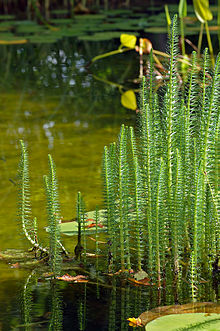- Common Mare's Tail
-
Common Mare's Tail 
Scientific classification Kingdom: Plantae (unranked): Angiosperms (unranked): Eudicots (unranked): Asterids Order: Lamiales Family: Plantaginaceae Genus: Hippuris Species: H. vulgaris Binomial name Hippuris vulgaris
L.The Common Mare's tail, Hippuris vulgaris, is a common aquatic plant of Eurasia and North America.
The species is also sometimes called Horsetail, a name which is better reserved to the Horsetails of genus Equisetum. These are unrelated to the water plant, though there is some resemblance in appearance.
The Common Mare's tail is a creeping, perennial herb, found in shallow waters and mud flats. It roots underwater, but most of its leaves are above the water surface. The leaves occur in whorls of 6-12; those above water are 0.5 to 2.5 cm long and up to 3 mm wide, whereas those under water are thinner and limper, and longer than those above water, especially in deeper streams. The stems are solid and unbranched but often curve, and can be up to 60 cm long. In shallow water they project 20–30 cm out of the water. It grows from stout rhizomes. The flowers are inconspicuous, and not all plants produce them.
Its distribution is circumboreal; in the United States it is found mainly in the northeast but extends southwards to New Mexico and Arizona. It prefers non-acidic waters.
In herbal medicine, Mare's tail has a number of uses, chiefly to do with healing wounds, e.g. stopping internal and external bleeding, curing stomach ulcers, and soothing inflammation of the skin. It has been said to absorb methane in large quantities and so to improve the air quality in the marshes where it is often found. It can however be a troublesome weed, obstructing the flow of water in rivers and ditches.
External links
- Jepson Manual Treatment
- USDA Plants Profile
- Fact sheet, taxonomic details, distribution maps, slideshow, and images of Hippuris vulgaris
Hipocris is another underwater plant related to this one above
Categories:- Plantaginaceae
- Aquatic plants
Wikimedia Foundation. 2010.
